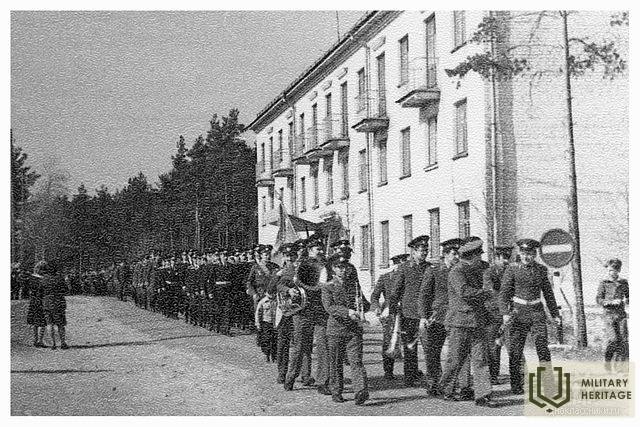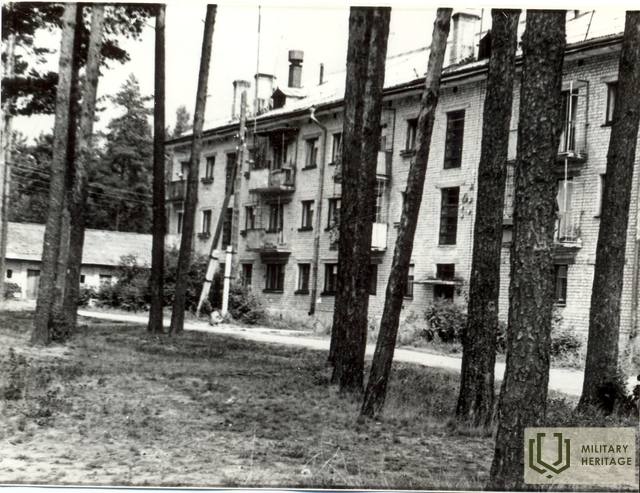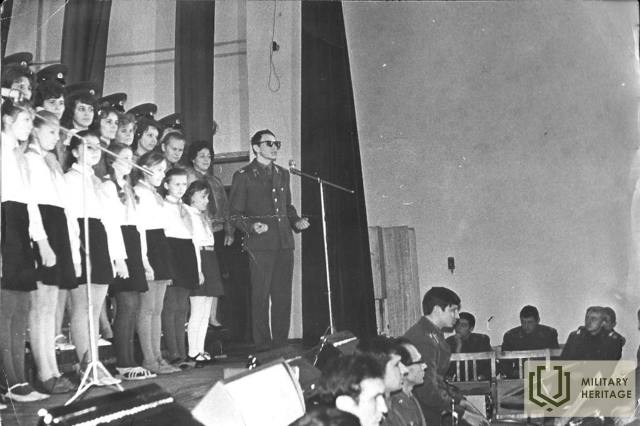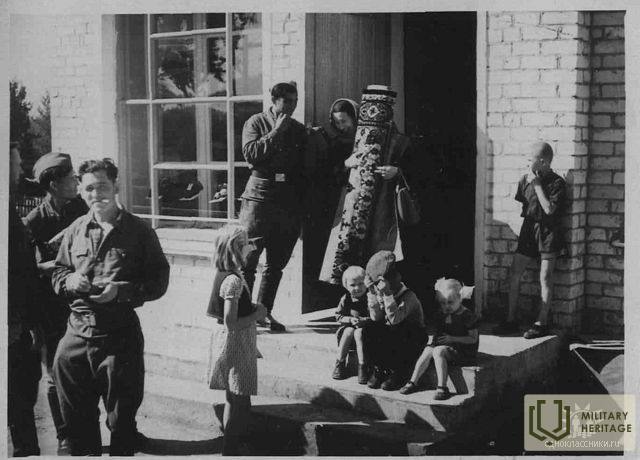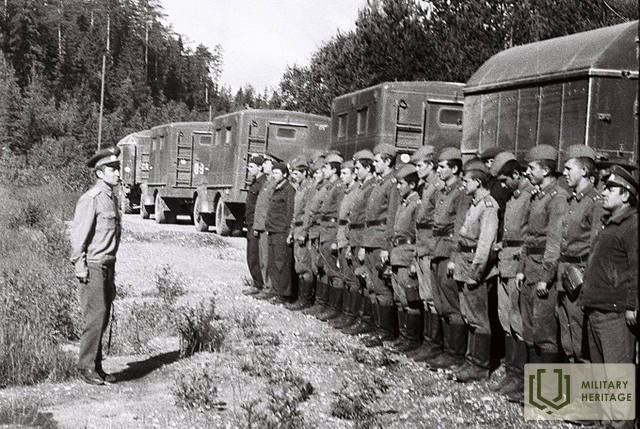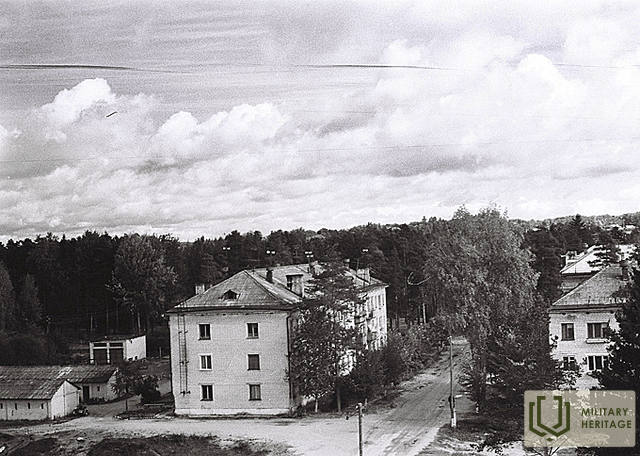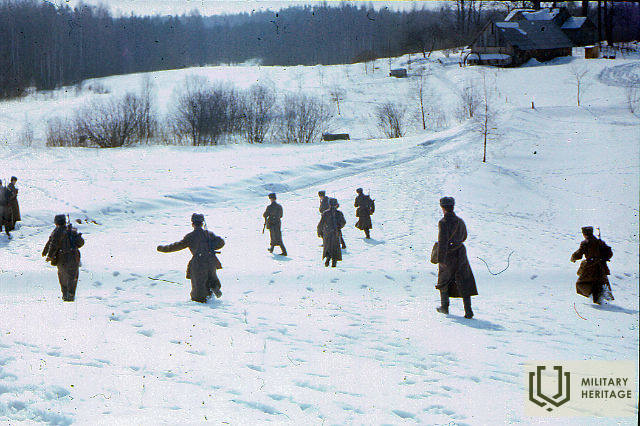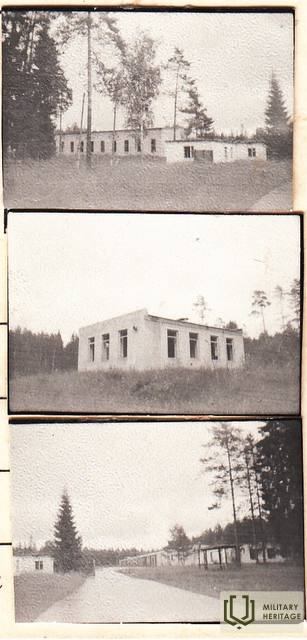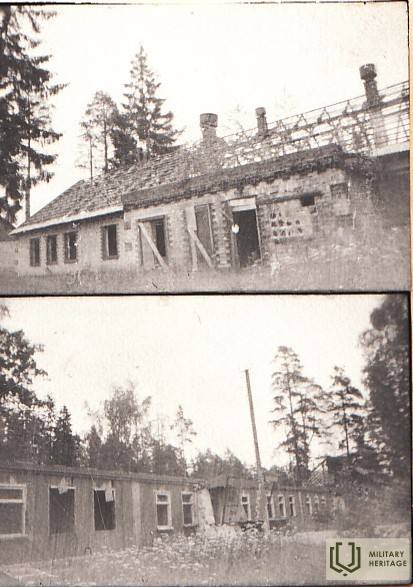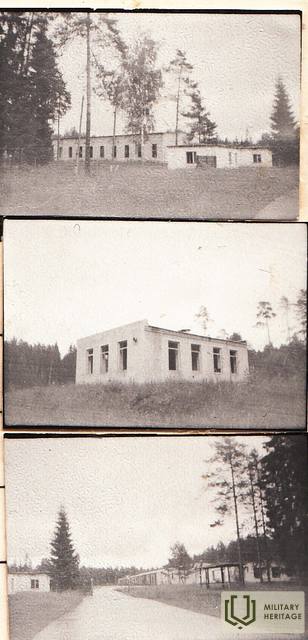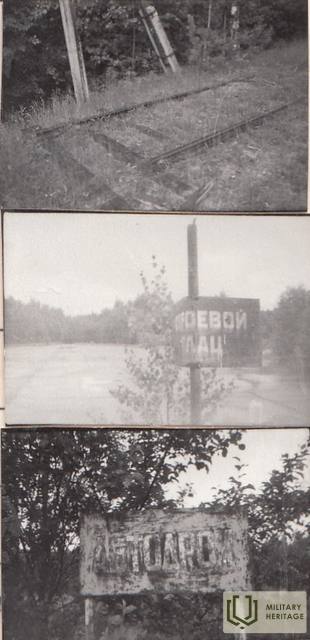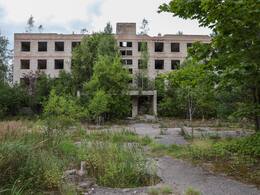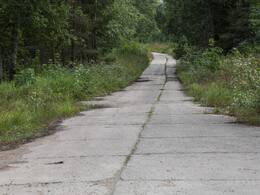SSRS armijos bazė Marcien mieste
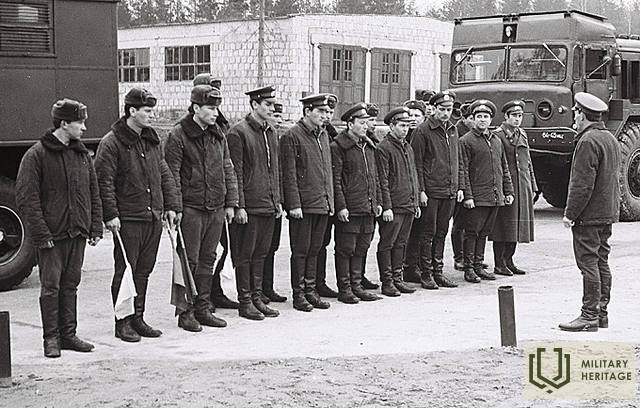
Baltijos šalys buvo viena svarbiausių Sovietų imperijos gynybos linijų, vakariausias bastionas, todėl kariuomenės koncentracija ten buvo milžiniška. Manoma, kad tuo metu Latvija buvo labiausiai militarizuota teritorija pasaulyje. Tikslus kariškių skaičius nežinomas, skirtingi šaltiniai skirtingais laikotarpiais mini nuo 200 000 iki 350 000. Vien Latvijoje per 50 metų buvo dislokuoti 3009 kariniai daliniai daugiau nei 700 vietų. Viena iš šių vietų buvo SSRS kariuomenės bazė Mārcienėje.
Formavimosi istorija
Mārcienos karinės bazės istorija prasidėjo šeštajame dešimtmetyje, kai Latvijos SSR Ministrų Taryba pradėjo svarstyti žemės perdavimo SSRS 15-osios armijos aviacijos daliniui klausimą. Naujo karinio objekto statyba buvo suplanuota Maduonos rajone.
1957 m. birželio 5 ir 6 d. visuotiniuose kolūkių „Zelta Druva“ ir „Darba Cilts“ susirinkimuose buvo pasirašyta sutartis dėl kelių šimtų hektarų žemės perdavimo naujai įkurtam kariniam daliniui. Iš viso karinėms reikmėms palaipsniui buvo skirta apie 477 hektarus žemės. Siekiant atlaisvinti vietos karinio objekto statybai, keli Mārcienų ir Bērzaunės apylinkių gyventojai turėjo palikti savo namus. Buvo uždarytas kelias Bērzaune–Valēni nuo „Līči“ iki „Aizkalnie“, o kelias Bērzaune–Mārcienai nuo „Saliņas“ iki „Patmalnieki“.
1957 m. kovo mėn. į Mārcienę atvyko pirmoji kariuomenės technika. Pagrindiniai karinės bazės statybos darbai prasidėjo 1958 m. Tuo pačiu metu buvo pastatyta kariuomenės mokymo bazė, gyvenamasis miestelis (esantis apie 2 km atstumu nuo mokymo bazės), betoniniai privažiavimo keliai, kariuomenės geležinkelis, sraigtasparnių nusileidimo aikštelė ir kiti karinės infrastruktūros objektai. Kol Mārcienėje dar nebuvo pastatytos kareivinės ir tarnybinis viešbutis, karininkai gyveno Madonos viešbutyje, o kiti statybininkai įsikūrė specialiai pastatytose medinėse kareivinėse Mārcienėje. Iš viso karinės bazės ir kariuomenės objektų statybose dalyvavo apie 5000 žmonių. Statybinės medžiagos ir reikmenys į bazę buvo pristatomi geležinkeliu.
Naujo karinio projekto sustabdymas
1960 m. buvo pradėtas darbas ties karinės bazės išplėtimo planais – iš Maduonos rajono kolūkių teritorijų buvo skirta papildomos žemės, o gyventojai buvo iškeldinti iš kelių Bėrzaunės valsčiaus sodybų. Gaiziņkalno apylinkėse buvo skirta papildomos žemės raketų paleidimo aikštelės statybai. Projekte taip pat buvo numatytas Gaiziņkalno apželdinimas mišku, siekiant paslėpti galimą raketų paleidimo aikštelę. Gali būti, kad dalis dabartinio eglyno Gaiziņkalnyje buvo pasodinta siekiant paslėpti planuojamą branduolinių raketų šachtą.
Siekiant paslėpti privažiavimo kelius, buvo pradėtas Bērzaunio apylinkių apželdinimas mišku ir pradėtas betoninio privažiavimo kelio iš Mārcienos per Bērzaunį tiesimas, nes civiliniai keliai dėl savo svorio nebūtų tinkami raketoms transportuoti, todėl raketoms perkelti reikėtų specialios kelio dangos ir geležinkelio. Taip pat buvo pradėta karinio geležinkelio, jungiančio bazes iš Mārcienos per Bērzaunį, statyba.
Nors Mārciena jau buvo tapusi sovietų kariškių rezidencija, Gaiziņkalno apylinkės liko nepaliestos, nes 1961 m. įvyko netikėtas įvykių posūkis – JAV ir Didžiosios Britanijos žvalgybos tarnybos atskleidė karinius planus Bērzaunės rajone. Rusijos karininkas, amerikiečių ir britų šnipas Olegas Penkovskis, buvo apkaltintas informacijos perdavimu Vakarų šalims, kurios neva informavo Didžiosios Britanijos žvalgybą apie planuojamą raketų paleidimo įrenginių vietą ir statybos planus. Ši žinia buvo transliuojama per radijo stotį „Amerikos balsas“. Vėliau, 1963 m., šnipui buvo skirta mirties bausmė, tačiau raketų paleidimo aikštelės statyba buvo sustabdyta.
Karinės stovyklos ir karinės bazės aprašymas
SSRS armijos bazė Mārcienėje tarnavo kaip bepiločių orlaivių (žvalgybinių orlaivių) dislokavimo vieta ir mokymo centras. Čia veikė bepiločių aviacijos pilotų mokykla su armijos mokymo įrangos baze: bepiločiai orlaiviai, mokomosios raketos, tankai ir šaudykla. Mārcienėje buvo dislokuoti lėktuvai „Striž“, kurie, be filmavimo, foto ir radijo įrangos, galėjo gabenti 100–200 kg sprogmenų arba branduolinių galvučių. Šios raketos skrido žemai, apie 50 m aukštyje, todėl radarai jų neaptiko. Vietovės gyventojai prisimena, kad už Bērzaunės, armijos dalinio teritorijoje, 1980-aisiais buvo įrengti mokomieji taikiniai. Mokomieji atakos į juos buvo vykdomos naikintuvais, šaudymas vyko elektroniniu režimu, nenaudojant šaudmenų. Mokomieji skrydžiai vyko iki 1989 m.
Marcieno armijos miestelyje buvo gyvenamieji pastatai, karininkų viešbutis, kultūros centras, mokykla, parduotuvė, valgykla, kareivinės, kareivinės, pirtis. Iš viso buvo 10 daugiabučių. Visuose juose buvo gyvenama, juose gyveno apie 400 kariškių šeimų. Iš viso Marciene apsigyveno keli tūkstančiai žmonių iš Sovietų Sąjungos, ir nuo to laiko Marcienė nebėra senoji Marcienė.
Karininkų namuose, laikantis laikmečio ir tradicijų, vyko socialinis gyvenimas – veikė šokių grupė, choras, ansamblis, pramogai buvo galima žaisti biliardą. Į Mārcienus tarnauti buvo pasiųstas iš Rygos sovietinės armijos Latvijos estrados ansamblio „Zvaigznīte“ narys (pianistas) Māris Briedis. Mārcienuose jis subūrė savo ansamblį ir tarnavo iki 1966 m.
Kovo mėnesį tarnaujantys kariai taip pat dalyvaudavo aplinkinių kolūkių talukuose – taip kurdami abipusį bendradarbiavimą. Buvo organizuojamos sporto varžybos, pavyzdžiui, žiemą – slidinėjimo varžybos tarp skyrių.
Karo miestelio vidurinėje mokykloje mokėsi apie 280 kariškių vaikų, o mokykla dirbo dviem pamainomis, nes visiems vienu metu neužteko vietos. Tarp kariuomenės bazės ir miestelio kursavo autobusas, su keliomis stotelėmis: Lakūnų mokykloje, Mokymo centre ir kt. Kaime buvo reguliariai patruliuojama tvarkai palaikyti, o ginklams ir sandėliams saugoti buvo laikomi šunys.
Medicinos priežiūrai taip pat buvo skirtas atskiras pastatas. Jame buvo ligoninė, vaistinė, odontologas ir ginekologas. Jame taip pat dirbo vietos darbuotojai iš Maduonos rajono. Po 1990 m. kariuomenė pati išvežė medicinos įrangą iš Mārcienos.
Karinis kompleksas buvo kūrenamas anglimi, kuri traukinio vagonais buvo pristatoma į Mārcienos stotį ir vėliau kraunama į automobilius. Anglies krovimo darbus daugiausia atliko Vidurinės Azijos tautybių atstovai – turkmėnai, tadžikai.
Kariniai objektai Mārcienėje turėjo įtakos Pliavinės–Maduonos plento planavimui ir statybai. Naujai nutiestas kelias negalėjo būti arčiau nei 1 km nuo karinės bazės. Nepaisant tuometinio kelių transporto ir greitkelių ministro Eduardo Liberto prieštaravimų, karinio personalo reikalavimai buvo patenkinti, ir atkarpa nuo Pilskalnio sudaro didesnį lanką arčiau Bērzaunės nei iš pradžių planuotas kelio variantas.
Kariuomenės bazė Mārcienėje po Latvijos nepriklausomybės atkūrimo
1994 m. SSRS armija paliko Marčienų bazę. Įrangą buvo planuojama išvesti 9 ešelonais. Paskutinis armijos ešelonas iš Marčienų išvyko 1994 m. kovo 25 d., ir nuo to laiko Marčienose nebuvo jokių Rusijos armijos dalinių. Kaip ir kiti Latvijos kariniai objektai, jis buvo perduotas valstybei, o vėliau savivaldybei. Vėliau didžioji dalis Marčienų bazės turto perėjo privačių asmenų nuosavybėn.
Netrukus į laisvai prieinamus armijos stovyklos butus atvyko gyventojai iš arti ir toli, įskaitant ir Rygą. Dauguma jų čia gyveno, kol išeikvojo sąskaitas už komunalines paslaugas, o tada dingo. Praeiviai aplinkinius negyvenamus namus laikė vieta, iš kurios galėjo pasiimti viską, ką galėjo – grindis ir langų rėmus, santechniką, radiatorius ar metalines dalis.
Iš Patmalniekų įsikūrusi Mārcienos 9-osios klasės mokykla persikėlė į buvusios Mārcienos vidurinės mokyklos pastatą Mežos gatvėje, kuriame mokėsi kariškių vaikai. Mokiniai naudojosi Karininkų namo sporto sale. Savo ruožtu mokykla, kurioje pagrindinė kalba buvo rusų, buvo perkelta į vieną iš karinio miestelio daugiabučių, jai buvo skirti 6 butai per du aukštus.
Kas išliko iki šių dienų
Šiuo metu buvusios karinės bazės teritorija nėra prieinama apžiūrai, ji apaugusi mišku, kai kurios privačios valdos naudojamos ūkinei veiklai. Ant kai kurių pastatų sienų išlikę užrašai, nurodantys Mārcienėje tarnavusių karių gyvenamąsias vietas: Ufą, Astaną, Orenburgą ir kt. Dalis buvusios bazės Mārcienėje taip pat buvo naudojama NAF (Nacionalinių ginkluotųjų pajėgų) ir Nacionalinės gvardijos karių, kurie kartu su užsienio sąjungininkais vykdė karines pratybas.
Betoninis privažiavimo kelias išliko kelyje Mārciena–Bērzaunė ir nedidelė jo dalis Bērzaunė–Gaiziņkalns atkarpoje, kuri buvo nutiesta numatytai raketų paleidimo vietai. Važiuojant per Bērzaunę Gaiziņkalns kryptimi, dešinėje pusėje, maždaug už šimto metrų nuo Gaizinja gatvės, taip pat aiškiai matyti buvęs geležinkelio pylimas.
Geriausiai išsilaikęs kariuomenės miestelis yra Mārcienėje, Mežos gatvėje. Buvęs kariuomenės karininkų tarnybos viešbutis, iš pradžių naudotas kaip mokykla ir darželis, dabar yra renovuotas pastatas, kuriame įsikūręs pensionas. Kariuomenė taip pat paliko kultūros (karininkų) namus, kurie šiuo metu Mārcienėje naudojami kultūriniams renginiams. Taip pat matyti buvusio kariuomenės dalinio gyvenamieji namai, kai kurie iš jų apgyvendinti, kai kurie apleisti, du daugiaaukščiai pastatai nugriauti.
Maduonos kraštotyros ir meno muziejaus kolekcija
Uldis Liniņš, „Mārcieno parapija“, 2006 m.
Madona – Gulbenės kalendorius 1997 m
Laikraštis „Diena“, 1993 m. sausio 16 d.
Laikraštis “Neatkarīga Cīņa” 1994.g. gruodžio 17 d.
Laikraštis „Žvaigždės“ 2017 m. gruodžio 8 d.
Laikraštis “Latvija Amerikā” 2005. Spalio 15 d.
LTV1 laida „Raktai“ 2018. „Okupantų kariuomenė palieka Latviją“
https://www.lsm.lv/raksts/dzive--stils/vesture/atslegas-krievijas-armijas-izvesana-nebeidzamas-beigas.a291354/
Bėrzaunės parapijos pirmininko ir buvusio karininko pasakojimas ir prisiminimai apie laiką, praleistą Mārcienėje
Susijusi laiko juosta
Susijusios temos
Susijusios vietos
Buvęs SSRS Marcieno armijos miestas arba „Gorodokas“
Įsikūręs Mārciene, Mārcieno valsčiuje, Madonos rajone.
1957 m. pradėta statyti raketinė bazė Mārcienoje, taip pat betoninio privažiavimo kelio ir geležinkelio tiesimas į Gaiziņkalnį, kur buvo planuojama įrengti raketų paleidimo aikštelę (kai JAV ir Didžioji Britanija atrado šį planą, statybos Gaiziņkalnyje buvo sustabdytos). Kariniame miestelyje buvo pastatyta keletas daugiabučių namų kariškiams iš kitų SSRS respublikų.
Šiuo metu buvusios kariuomenės bazės teritorija yra iš dalies apleista ir apaugusi krūmais, dalis jos priklauso įmonėms ar privatiems asmenims ir nebėra prieinama visuomenei. Kariuomenės bazė daugiausia yra mūrinių pastatų lūšnynas. Mārcienos kaime – daugiabučiai (kai kurie vis dar gyvenami), kariuomenės karininkų bendrabutis (buvęs Mārcienos pradinės mokyklos pastatas), karininkų namas (Mārcienos kultūros namai) ir kariuomenės parduotuvės pastatas.




